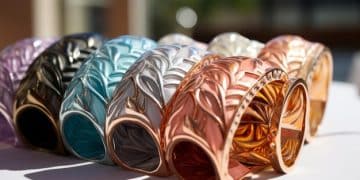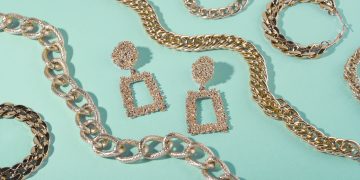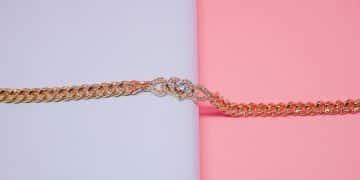Trending Now: 7 Fashion Jewelry Metals for Sensitive Skin (2025 Update)
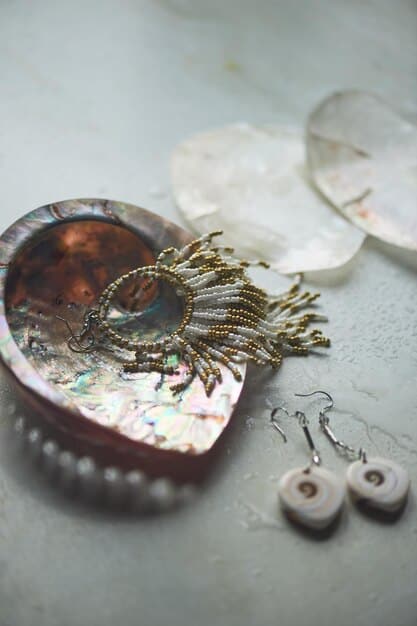
Navigating the world of fashion jewelry with sensitive skin can be challenging, but advancements and renewed popular interest in specific metals offer solutions, with notable options like surgical stainless steel and titanium leading the way for irritation-free wear, updated for the trends of 2025.
Are you someone who loves fashion jewelry but constantly battles with skin irritations, redness, or itching? You’re not alone. Finding pieces that don’t cause a reaction can feel like a treasure hunt. Fortunately, as we look to 2025, several metals are emerging and solidifying their place as top choices for those with delicate skin, ensuring you can embrace the latest styles without discomfort. Say goodbye to allergic reactions and hello to gorgeous, wearable pieces that truly enhance your look, because this guide to Trending Now: 7 Fashion Jewelry Metals That Won’t Irritate Sensitive Skin (Updated for 2025) is here to help you navigate the best choices available.
Understanding Skin Sensitivity and Jewelry
Skin sensitivity to jewelry is a common issue, often manifesting as redness, itching, swelling, or even blistering at the contact site. This uncomfortable reaction is typically an allergic contact dermatitis, most frequently triggered by specific metals present in the alloy of the jewelry piece. While many assume it’s a sign of low-quality jewelry, even high-end pieces can contain irritants if not chosen carefully.
The primary culprit behind these reactions is almost always nickel, a highly allergenic metal that is unfortunately quite common in many jewelry alloys due to its durability and affordability. However, other metals like copper, cobalt, and even some types of gold alloys can also cause reactions in highly sensitive individuals. Understanding the root cause of your skin’s irritation is the first step towards choosing jewelry that won’t cause discomfort.
The Culprits: Common Irritants in Jewelry
Identifying which metals are most likely to cause a reaction is crucial for informed purchasing. Nickel stands out as the most prevalent allergen, but it’s not the only one. Many costume jewelry pieces, especially those sold at lower price points, contain high levels of nickel because it’s a cost-effective way to strengthen alloys and add shine. Unfortunately, its widespread use makes it difficult to avoid without specific knowledge.
- Nickel: The most common allergen, leading to contact dermatitis.
- Copper: Can cause green discoloration on the skin and, in some cases, mild irritation.
- Cobalt: Less common than nickel, but also a known allergen for some individuals.
- Cadmium & Lead: Highly toxic metals, now largely restricted in jewelry production due to health risks, but still found in older or unregulated pieces.
While gold and silver are generally well-tolerated, it is the alloys mixed with them that can cause problems. For instance, white gold is often alloyed with nickel to achieve its color, and even yellow gold can contain trace amounts of copper or other irritants, particularly in lower karats. Therefore, the purity and composition of the metal are critical factors to consider when selecting jewelry for sensitive skin.
Looking ahead to 2025, there’s a growing movement towards transparency in sourcing and manufacturing, meaning it’s becoming easier to find high-quality, hypoallergenic options. Consumers are increasingly empowered to ask questions about metal composition and demand safer alternatives. This shift, driven by both consumer awareness and ethical manufacturing practices, is making the jewelry market more inclusive for everyone, especially those with sensitive skin.
Surgical Stainless Steel: The Undisputed King
When it comes to hypoallergenic jewelry, surgical stainless steel has long reigned supreme, and its popularity is only set to grow by 2025. This isn’t just common stainless steel; surgical grade, typically 316L, is specifically formulated to be biocompatible, meaning it’s designed to interact safely with the human body. It is widely used in medical implants and body piercings precisely because of its inert nature and resistance to corrosion, which means it won’t leach irritating metals into your skin.
The beauty of surgical stainless steel for fashion jewelry lies in its versatility and durability. It can be polished to a high shine, brushed for a matte finish, or even plated with other metals like gold or rose gold. This flexibility allows designers to create a vast array of stylish pieces, from minimalist earrings to chunky chain necklaces, all while maintaining the promise of irritation-free wear. Its inherent strength also makes it resistant to scratches and tarnishing, ensuring your pieces look great for years to come without requiring much maintenance.
Why 316L is Your Best Friend
The “316L” designation isn’t just a random number; it refers to a specific type of surgical stainless steel with a very low carbon content. This low carbon content makes it even more resistant to corrosion and sensitization, reducing the likelihood of nickel ions migrating to the skin. While surgical stainless steel does contain some nickel, it is bound tightly within the alloy structure, forming a passive layer that prevents it from reacting with human tissue. This is why it’s considered safe for implant procedures and, by extension, for sensitive skin.
- Biocompatibility: Engineered to be non-reactive with body tissues.
- Corrosion Resistance: Prevents leaching of irritating metals.
- Durability: Highly resistant to scratches, dents, and tarnishing.
- Versatility: Can be styled and finished in numerous ways to suit current trends.
The trend for 2025 sees surgical stainless steel moving beyond basic designs into more intricate and high-fashion pieces. Designers are leveraging its robust nature to create innovative forms and incorporate it into mixed-metal designs, often paired with elements like natural stones or even ethically sourced wood. This elevates surgical stainless steel from a merely functional material to a fashion-forward choice, proving that comfort doesn’t have to compromise style. Its affordability also ensures that chic, hypoallergenic jewelry is accessible to a wider audience, democratizing sensitive skin-friendly fashion.
Titanium: Lightweight and Hyper-Allergenic
Titanium is another exceptional choice for those with highly sensitive skin, often preferred even over surgical stainless steel by individuals with extreme metal sensitivities. Its reputation stems from its superior biocompatibility; it is virtually unreactive to human skin and is widely used in medical implants, including joint replacements and dental implants. This makes it an ideal material for jewelry, particularly for piercings or pieces worn for extended periods.
What sets titanium apart, especially in 2025, is its incredible strength-to-weight ratio. It’s incredibly durable yet remarkably lightweight, meaning even substantial pieces made from titanium feel barely there when worn. This comfort factor is a significant advantage for earrings, large necklaces, and bracelets, where weight can sometimes cause discomfort or strain. Furthermore, titanium is naturally resistant to corrosion, tarnishing, and rust, ensuring your jewelry retains its pristine appearance without constant polishing.
Anodization and Color Choices for 2025
One of titanium’s most captivating features for fashion purposes is its ability to be anodized. Anodization is an electrochemical process that creates an oxide layer on the surface of the metal, altering how light reflects off it and resulting in a stunning array of vibrant colors without the use of dyes or plating. This means the color is integral to the metal itself, making it incredibly durable and chip-resistant, unlike traditional surface coatings.
- Exceptional Biocompatibility: One of the most inert metals, virtually eliminating allergic reactions.
- Superior Strength-to-Weight Ratio: Extremely durable yet incredibly light.
- Tarnish and Corrosion Resistant: Maintains its look without special care.
- Vivid Colors: Anodization offers a spectrum of permanent, hypoallergenic hues.

The trend for 2025 shows an increased interest in color, and titanium’s anodizing capabilities fit perfectly into this aesthetic. From subtle pastels to electric blues and purples, titanium jewelry can be a vibrant statement piece without any of the risks associated with plated or painted metals. Its versatility in color and form means designers are increasingly experimenting with titanium, creating avant-garde and contemporary pieces that are as unique as they are safe for sensitive skin. This makes titanium a standout choice for those looking to combine bold style with uncompromising comfort.
Niobium: Another Biocompatible Powerhouse
Niobium, while less commonly known than titanium or surgical stainless steel, is another excellent contender for hypoallergenic fashion jewelry. Like titanium, niobium is a highly inert and biocompatible metal, making it exceptionally safe for individuals with extreme metal sensitivities. It’s frequently used in medical devices and, increasingly, in high-quality body jewelry, a testament to its non-reactive nature. Its hypoallergenic properties mean it’s virtually impossible to trigger an allergic reaction, even in the most sensitive individuals.
Similar to titanium, niobium can also be anodized to create a wide spectrum of iridescent colors without the use of dyes. This process creates a thin, transparent oxide layer that refracts light, resulting in brilliant, non-fading colors that are an intrinsic part of the metal. This makes niobium jewelry vibrant and eye-catching, yet completely safe against the skin. Its light weight and durability further enhance its appeal, providing comfort and longevity for any jewelry piece.
Niobium’s Growing Fashion Appeal for 2025
As consumers become more aware of metal sensitivities and seek out safer alternatives, niobium is poised to gain more traction in mainstream fashion jewelry for 2025. Its vibrant color possibilities, combined with its exceptional safety profile, make it an attractive option for designers looking to create unique and inclusive pieces. Whether it’s used for delicate wirework earrings or bold, statement necklaces, niobium offers a blend of artistic potential and practical benefits that few other metals can match.
- Extreme Hypoallergenic Properties: Highly resistant to reactions, suitable for even the most sensitive skin.
- Anodizable Colors: Offers a stunning range of permanent, vibrant hues without plating.
- Lightweight and Durable: Comfortable for extended wear and resistant to damage.
- Rising Popularity: Gaining recognition as a premium hypoallergenic metal for fashion.
The ethical sourcing and sustainable production practices are also becoming more important to consumers, and niobium fits well into this narrative as a responsible choice. As the fashion industry continues its shift towards more mindful consumption, metals like niobium, with their inherent safety and environmental advantages, are likely to see increased demand. This positions niobium not just as a niche option, but as a significant player in the future of hypoallergenic fashion jewelry.
Sterling Silver (Nickel-Free): Classic Elegance, Reimagined
Sterling silver has always been a beloved choice for jewelry due to its beautiful luster and timeless appeal. However, traditionally, sterling silver contains 7.5% copper and small trace amounts of other metals, which can include nickel to add strength or reduce cost. For individuals with sensitive skin, this traditional formulation can often lead to irritation. The good news for 2025 is the increasing availability and popularity of nickel-free sterling silver alloys, making this classic metal accessible to a wider audience.
These new formulations maintain the beautiful shine and malleability of traditional sterling silver but substitute nickel with alternative metals like germanium, zinc, or palladium. This results in an alloy that is less prone to tarnishing, more durable, and, most importantly, hypoallergenic. Jewelers are embracing these advanced silver alloys, allowing them to create intricate and delicate designs without compromising on skin safety. This means you can enjoy the elegance of silver without the worry of allergic reactions.
Identifying Truly Hypoallergenic Silver
To ensure you’re purchasing truly hypoallergenic sterling silver, look for explicit labeling such as “nickel-free sterling silver,” “925 nickel-free,” or sometimes “Argentium silver,” which is a specific brand of tarnish-resistant, nickel-free sterling silver alloy. Generic “sterling silver” might still contain trace amounts of nickel, so always verify the composition with the seller if you have sensitivities. The shift towards greater transparency in labeling is a positive trend for 2025, enabling consumers to make more informed choices.
- Timeless Aesthetic: Offers the classic beauty and versatility of silver.
- Nickel-Free Formulations: Modern alloys eliminate the common allergen.
- Reduced Tarnish: New compositions often resist tarnishing better than traditional sterling.
- Versatile for Design: Remains a favorite for intricate and varied jewelry styles.
Nickel-free sterling silver is perfect for those who appreciate traditional elegance but require a safe option for their skin. It’s an excellent choice for everyday wear as well as special occasions, offering a sophisticated look without the discomfort. As conscious consumerism continues to rise, the demand for transparently sourced and hypoallergenic materials like nickel-free sterling silver is driving innovation in the jewelry market, ensuring beautiful and safe options are readily available.
High-Karat Gold: The Purest Indulgence
Gold is often considered the epitome of luxury in jewelry, and for those with sensitive skin, high-karat gold can be an excellent choice, particularly for 2025. The “karat” refers to the purity of the gold, with 24-karat being 100% pure gold. However, pure gold is very soft and easily scratched or bent, making it impractical for most jewelry. Therefore, gold is alloyed with other metals to increase its durability, and it’s these alloys that can sometimes cause skin reactions.
For sensitive skin, the general rule is: the higher the karat, the better. This is because higher karat gold contains a larger percentage of pure gold and a smaller percentage of other metals that might cause irritation. While 10K or 14K gold are common, they contain significantly more alloyed metals (like copper, silver, or even nickel in some white gold formulations) than 18K or 22K gold. Therefore, opting for 18K gold or higher significantly reduces the risk of allergic reactions.
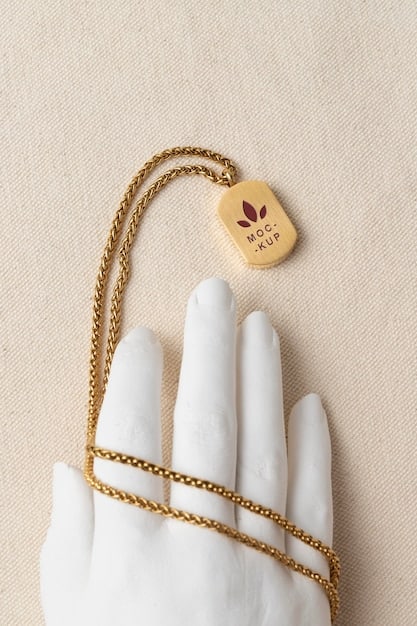
Choosing the Right Karat and Color for Sensitive Skin
When selecting gold for sensitive skin, consider both the karat and the color. Yellow gold is typically the safest option, as its alloys usually consist of copper and silver, which are less likely to cause reactions than other metals. White gold, on the other hand, traditionally uses nickel as an alloying agent to achieve its silvery-white color, which can be problematic. If you prefer white gold, look for palladium white gold or platinum-alloyed white gold, which are naturally hypoallergenic.
- Higher Purity, Lower Risk: 18K and 22K gold contain minimal potentially irritating alloys.
- Yellow Gold Recommended: Alloys with copper and silver are generally well-tolerated.
- Palladium White Gold: A safe alternative for those preferring white gold.
- Investment in Comfort: A more luxurious and lasting solution for sensitive skin.
For 2025, high-karat gold continues to be a symbol of enduring value and style. Its inherent hypoallergenic properties, especially in purer forms, make it a natural fit for the discerning consumer who values both luxury and comfort. While it comes with a higher price tag, the investment in high-karat gold ensures not only a beautiful piece of jewelry but also peace of mind, knowing it won’t cause irritation.
Platinum: The Ultimate Hypoallergenic Luxury
Platinum stands as one of the most prestigious and truly hypoallergenic metals available for jewelry, making it an enduring choice for sensitive skin in 2025 and beyond. This naturally white metal is incredibly dense, durable, and remarkably resistant to tarnish and corrosion. Unlike white gold, which often relies on nickel and a rhodium plating to achieve its luster, platinum is naturally white and does not require plating. Its purity, typically 90-95% pure in jewelry, means it contains very few other metals, and those it does use (like iridium or ruthenium) are also highly inert and non-allergenic.
The weight and substantial feel of platinum jewelry are often perceived as a sign of its quality and luxury. It’s an investment metal that holds its value, and its hypoallergenic nature adds to its appeal for discerning buyers. While platinum may be more expensive than gold, its longevity and inherent safety for sensitive skin make it a worthwhile choice for heirloom pieces and everyday wear alike.
Why Platinum Reigns Supreme for Sensitivities
Platinum’s excellent biocompatibility is well-documented, as it is widely used in countless medical and dental implants. This translates seamlessly into jewelry, where it virtually eliminates the risk of allergic reactions. Its natural white color means it won’t fade or change over time, and its remarkable strength ensures that prongs holding gemstones remain secure. It develops a natural patina over time, which adds to its unique character but doesn’t diminish its integrity or hypoallergenic properties.
- Naturally Hypoallergenic: Extremely pure and inert, superior for sensitive skin.
- Exceptional Durability: Resists wear and tear, ideal for daily use.
- Naturally White: No need for plating, maintaining its color perpetually.
- Investment Quality: A luxurious and lasting choice with high intrinsic value.
In 2025, platinum continues to be chosen by those who seek the highest quality and safety in their jewelry. Its understated elegance and robust nature make it perfect for engagement rings, wedding bands, and any fine jewelry piece intended to be cherished for a lifetime. For anyone with extreme metal sensitivities who desires top-tier luxury, platinum is an unparalleled choice, offering both beauty and complete peace of mind.
Rhodium Plating: A Temporary Shield for Sensitive Skin
While not a solid metal to form an entire piece of jewelry from, rhodium plating plays a significant role in making typically irritating metals safer for sensitive skin. Rhodium is an extremely rare and precious metal, a member of the platinum family, known for its brilliant white luster and exceptional hardness. Because it is naturally hypoallergenic and highly resistant to corrosion, it is commonly used as a thin protective layer over other metals, most notably white gold and sometimes sterling silver.
The primary purpose of rhodium plating is to give white gold its bright, silvery-white finish (as white gold alloys are often yellowish) and to provide a hypoallergenic barrier between potentially irritating metals (like nickel in some white gold) and the skin. For sensitive individuals, this plating acts as a shield, preventing direct contact with the underlying metal. It can also enhance the shine and durability of sterling silver, making it more resistant to tarnishing.
Maintenance and Limitations to Consider
While rhodium plating offers a fantastic temporary solution, it’s crucial to understand its limitations. Being a very thin layer, it can wear off over time, especially on frequently touched areas like the underside of rings. Once the plating wears down, the underlying metal is exposed, potentially leading to skin irritation. The lifespan of rhodium plating varies depending on wear, but typically it may need re-plating every 1-3 years for rings, less frequently for earrings or necklaces.
- Effective Barrier: Creates a hypoallergenic surface over potentially irritating metals.
- Enhanced Luster: Provides a brilliant, mirror-like finish to white gold and silver.
- Increased Durability: Adds a layer of protection against scratches and tarnish.
- Temporary Solution: Requires re-plating as it wears off over time.
By 2025, jewelers are increasingly transparent about rhodium plating, advising customers about its maintenance requirements. While it’s not a permanent solution, rhodium plating remains a valuable option for extending the wearability of certain jewelry types for those with sensitive skin. It allows consumers to enjoy the aesthetic of white gold and silver without immediate allergic reactions, provided they are aware of the need for periodic re-plating.
| Key Metal for Sensitive Skin | Why It’s Trending (2025) |
|---|---|
| ✨ Surgical Stainless Steel | Biocompatible & durable, perfect for everyday wear. |
| 💡 Titanium | Super lightweight, hyper-allergenic, vibrant anodized colors. |
| 🌟 Niobium | Similar to titanium, excellent for extreme sensitivities, versatile colors. |
| 💎 Platinum | The ultimate luxury, naturally white, and supremely hypoallergenic. |
Frequently Asked Questions About Hypoallergenic Jewelry
▼
The most hypoallergenic metals are typically titanium, niobium, and platinum due to their extreme inertness and purity. Surgical stainless steel (316L) is also highly biocompatible and a very popular choice. These metals are celebrated for their minimal reactivity with human skin, significantly reducing the risk of allergic reactions even for very sensitive individuals. This makes them ideal for prolonged wear.
▼
Yes, you can, but choose high-karat gold (18K or higher) as it contains a smaller percentage of potentially irritating alloyed metals. For white gold, specifically look for palladium white gold instead of traditional nickel-based white gold. Always inquire about the gold’s alloy composition when purchasing to ensure it’s free of common allergens like nickel, making it safer for your skin.
▼
Traditional sterling silver can sometimes cause irritation due to its copper content or trace nickel. However, modern nickel-free sterling silver or Argentium silver alloys are excellent hypoallergenic alternatives. These newer formulations maintain the beauty of silver while eliminating common irritants, ensuring you can enjoy classic silver jewelry without discomfort. Always check for “nickel-free” labeling.
▼
Rhodium plating creates a thin, protective, and hypoallergenic barrier over underlying metals that might cause irritation, such as white gold with nickel content. It provides a brilliant, shiny finish and temporary comfort for sensitive skin. However, since it is a plating, it will wear off over time and might require re-plating periodically to maintain its protective qualities.
▼
Titanium is exceptionally lightweight, incredibly durable, and highly biocompatible, making it ideal for sensitive skin. It causes virtually no allergic reactions and is resistant to corrosion and tarnishing. Additionally, titanium can be anodized to produce a wide range of vibrant, permanent colors without dyes or plating, offering stylish and safe options for those prone to skin irritations.
Conclusion
Navigating the world of fashion jewelry with sensitive skin no longer means sacrificing style for comfort. As we move into 2025, the increased awareness and technological advancements in metallurgy have brought forth a fantastic array of hypoallergenic metals that cater to even the most delicate skin types. From the tried-and-true reliability of surgical stainless steel and the supreme biocompatibility of titanium and niobium, to the redefined elegance of nickel-free sterling silver, the enduring luxury of high-karat gold, and the ultimate prestige of platinum, consumers now have more safe and stylish options than ever before. Understanding the properties of these metals and making informed choices empowers you to embrace trending designs without the discomfort of allergic reactions. By prioritizing quality and composition, you can confidently build a jewelry collection that is both beautiful and gentle on your skin, allowing your personal style to shine without compromise.
